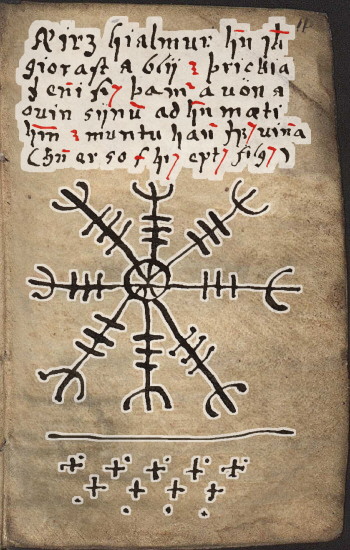Galdrastafir: Icelandic Magical Staves
Aegishjalmur, Vegvisir, Lukkustafir and other sigils
Their meaning, history and use in grimoires, charms and tattoos
★ Jump straight to ⇒ VEGVISIR ⇐ section below. ★
★ Jump straight to ⇒ AEGISHJALMUR ⇐ section below. ★
★ Jump straight to ⇒ LUKKUSTAFIR ⇐ section below. ★
Foreword:
If you have any questions or want the latest information just ask me - I’ll answer as soon as possible. I can also help with tattoo design of Galdrastafir, Bindrunes, Runic writing and advice on their original meaning. I use only my own extensive research of authentic Icelandic manuscripts and related historic source writings.

Note that my replies often end up in spam folders - always check
spam and deleted emails if you've been waiting a couple of days.
Don't risk believing the misinformation and mistaken designs seen elsewhere on the internet.
When seeing my first galdrastafur symbol (the Vegvisir/Vegvísir tattoo on the arm of Icelandic singer Björk) I was immediately intrigued by the design and then fascinated as I learnt more about it. I quickly discovered the design of this symbol often differed and its meaning sometimes varied. Particulars were vague at best and sometimes not even known. This aspect carried through to all galdrastafir. Thus began my quest to discover everything I could about these amazing symbols and the culture supporting them.
Above all let me stress three things:
1. Galdrastafir are Icelandic and appear from around 1400 through to 1800 (late middle-age to early modern period). Most are from the 17th century, and there are hundreds of them. For example, many websites like to claim the Vegvisir/Vegvísir is a "Viking Compass" - this is not true! The "Viking Period" ends prior to 1100 AD and that there are 8 points like a compass is just coincidence. Many staves have 8 points, or 6 or 4.
2. They borrow concepts from pagan times, from Vikings, from Norse / Nordic gods, myths and folklore, and from runic characters, but they also reflect issues current for their time and strong Christian (Lutheran) beliefs. It is likely that Galdrastafir gained popularity in Iceland after other symbols were seen in middle-age grimoires from mainland Europe.
3. Since 1800 CE, Galdrastafir have been drawn and redrawn, often in compilations, and on many occasions done with missing or added elements that change how they originally looked.
If you are interested in using these symbols, please do so wisely. Don’t assume the design you’ve seen on Tumbler or Etsy or even Wikipedia are correct. Esotoric (contemporary) rune meanings have little to do with Galdrastafir. Ásatrú, Odinism and Shamanism (all new age pagan or heathen religions) have adopted some of the symbols for use in their own belief systems - this does not mean the symbols are pagan or heathen or symbolic of any particular group.
Update:
With considerable help and a lot of hard work I have completed my first academic work and made it available to public. It is a full transliteration and translation into English of the first manuscript I saw that showed an original Vegvísir:
| Huld Manuscript of Galdrastafir Magic Symbols and Runes: Translation |
And now my second project, two years in the making, is available. This is a translation into English of the wonderful 1903 essay by Ólafur Davíðsson entitled Isländische Zauberzeichen und Zauberbücher
:
| Icelandic Magic Symbols (galdrastafir) and Spell Books (galdrabækur) |
Latest news:

I have opened for business! As Norse Graphics
I now provide my graphic design of Galdrastafir, Bindrunes and Runic writing for a small charge in an effort to help fund my continued research. I hope you will understand and eagerly buy something.
The easy way is to click the PayPal button wherever you see something you like. Alternatively send me an email and let me help you that way. As always, my replies to your general enquiries will always be free.
Galdrastafir Definition and Meaning
Galdrastafir (pl. of galdrastafur) is an Icelandic word which translates to [galdra] magical
[stafi] sticks
or staves. Steven Flowers writes that they inherited from the old technical designation of runes as staves or sticks because they were often carved on such objects for talismanic purposes
.3 A stave (from Old English: staves
pl. of staff
) is generally some kind of straight supporting structure: a walking stick or staff; a small beam or strut; or the lines drawn holding musical notes and other symbols. However the galdrastafir is best defined as a sigil - an inscribed or painted magical sign or symbol or even a family type seal. They were usually designed to control the elements
or steer developments
. On its own the word stafr
in Icelandic also means a letter (of the alphabet) or character and also means lore or wisdom.
The shape of the symbols could be grouped into five:
1. Asymmetrical - These are often the older galdrastafir, and rarely have any Christian influence. They are characterized more to the traditional definition of stafi
, commonly with straight lines intersected with other lines or small shapes. The small shapes are runes in the old sense definition, i.e. a character with hidden meaning. Very occasionally one or more recognisible runes are used, however it is a fallacy to presume galdrastafir are made up of Futhark
rune characters.
| To reveal a thief LBS 4375 8vo |
To hide something LBS 2413 8vo |
For good sailing LBS 764 8vo |
For fear of the dark LBS 143 8vo |
2. Symmetrical - These later aged galdrastafir have greater esthetic value and range from the most simple to very complex and elaborate forms. Some intermix Christian and Pagan elements, or are solely Christian related. Many take the cartwheel
form, often with identical rune shapes at the end of each spoke.
| A very old symbol AM 158 4to |
Against all magic LBS 4627 8vo |
For enemy’s anger LBS 764 8vo |
Against all evil LBS 4689 8vo |
For many thoughts LBS 977 4to |
To keep people out ATA Ämb2 F16:26 |
3. Runic - These are generally a string of single or multiple characters. Again, the meaning of the runic shapes are usually unknown or unclear to us.
| To make enemies afraid ATA, Ämb 2, F 16:26 |
To get your wish LBS 2413 8vo |
To reveal a thief ÍB 383 4to |
4. Seal / Insignia - These are almost all Christian influenced, with names given to the symbol such as Seal of Jesus
or other entities including Christian leaders, monarchs and angels. The most frequent of these refer to Jesus/Christ/Jehovah/IHS, King Salomon or are labeled as a Rood Cross
. Many seem to have shapes and words that are similar to those found in early-modern European grimoires.
| Salomons síGíllum LBS 143 8vo |
Davíds Ínnsíglí ÍB 383 4to |
Drotningarsignet DFS 1883/67 |
Insiglia LBS 977 4to |
5. Superstaves - These are the most complex and often the most beautiful of the symbols. They often fall under the Rood-cross
banner (spelt variously in Icelandic as Rúdukross, Ródukross or Rotaskross) and are mostly used for protection against evil.
This is one of the more grand Christian type galdrastafir as it appears in 3 source documents/manuscript. The one from Galdraskraeda I believe has been added to by the scribe and comes with words written in 16th century runes: this is rotas cross - sun cult of Enoch's pillar
. It has many Masonic references, and actually there is even more to it which I have omitted, including drawings of the Four Evangelists in their animal form. The Rotas
variation is a reference to the very ancient magical Sator Arepo Square.
They commonly include the main features of drawn circles, semi-circles (inward or outward facing cup shapes), straight lines, and six or eight spoked wheels
. Short lines are often in multiples of three.
These elaborate symbols often are dedicated to some Christian Saint or other religious figurehead.
The Museum of Icelandic Sorcery & Witchcraft have a comprehensive catalogue of Galdrastafir on their web page called Magical Staves.
Magical properties were instilled by the sigil’s creator, often an old school magician, witch/sorcerer or shaman. Icelandic legends tell of magicians nearly all schooled overseas (Germany or other Nordic countries) for the purpose of becoming Christian clergy. The general population was largely illiterate. In Iceland these people were called galdramenn
or seið-maðr/kona
. It is speculated that they would draw, scratch, carve or engrave lines and symbols, often runic-like characters, and employ ritualistic processes as they fashioned the sigils.
Use common sense. How does writing a rune on a piece of paper solve anything? That sounds superstitious doesn’t it? On the other hand, if the rune is used to provoke action, or another perspective, or as a reminder - then you see it may have some kind of impact. - Tyriel 2011
Aspects of galdrastafir are steeped in Germanic history, connections with Norse pagan gods and goddesses and rune alphabet characters going back centuries. It also seems likely that the form these staves take were inspired by the sigils found in mainland grimiores - the Key of Solomon the King
being one most likely candidate. Runes were used for writing throughout the Germanic and Scandinavian regions up until around 1000CE, at which point their use declined except for marking graves, personal items and less frequently for charms and amulets. From 800CE to 1200CE people colonized and populated Iceland and carried with them the magical practices, their gods and the runes.
 |
Elder Futhark (ca. 200 to 800 CE) |
 |
Long Branch Younger Futhark (8th cent CE) |
 |
Modified Danish Futhark (ca. 1300 CE) |
The following inscribed runestone is dated to viking times, using a transitional combination of Younger and Modified Futharks and includes dotted m
runes - a form which may explain the dots seen in the vegvísir symbol discussed later.

|
DR 68 (DK MJy 79) - AARHUS, MIDTJYLLAND 19 |
 |
|
|
TRANSLITERATION:
(-)usti × auk × hufi × auk × þiR × frebiurn × risþu × stin × þonsi × eftiR ×
× osur × saksa × filaka × sin × harþa × kuþan × trik × saR × tu × × mana × mest × uniþikR × saR × ati × skib × miþ × arno + |
|
|
NORSE TRANSLATION:
[T]osti ok Hofi ok þeir Freybjôrn reistu stein þenna eptir
Ôzur Saxa, félaga sinn, harða góðan dreng. Sá dó manna mest óníðingr, sá átti skip með Arna. |
|
|
ENGLISH TRANSLATION:
Tosti and Hofi and Freybjôrn, they raised this stone in memory of
Ôzurr Saxon / Sword(-wielder), their partner, a very good valiant man. He died as the most unvillainous of men; he owned a ship with Árni. |
|
| ⇧ Click on the picture to toggle on and off rune highlighting. | |
Note however there are very few written records in Iceland prior to 1200 CE. History was kept by the telling of stories, which were passed down through the ages. It was only later that some documents of the magic, the stories and traditions were written down, including the Prose Edda, the Poetic Edda and the Sagas of Icelanders in the 13th and 14th centuries. Grimoires, textbooks of magic, were rarely made or kept, however some survived. The best of these is the Galdrabók, which gives detailed information about the creation of the sigils. All of these were written using Latin characters, although often old script makes them difficult to read. Runes do appear as alphabetic lists in 17th century scholarly Icelandic manuscripts, but the most significant entry is the Icelandic Rune Poem written approximately in 1300 CE.
Icelandic legends tell of wizards/magicians that made grimoires written in runes. However the runes they speak of are not those of the alphabetic fathark shown above. What is meant is they were written in secret language
. There have been some compilation manuscripts that have used the Modified Danish Futhark or similar to describe the use or purpose of the sigils - most notable among which are the Huld manuscript and the 1940 magazine-like Skuggi Galdra-skræða
.
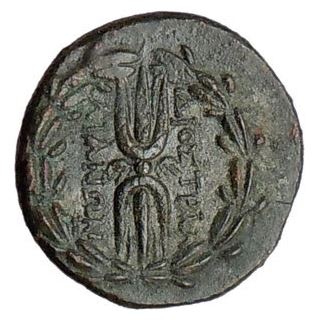 |
| Thyatira Coin |
 |
| Donderbezem |
The late Matthías Viðar Sæmundsson gave a lecture 26 in which he put forward the idea that the tvimadur shape (Icel. tvi=two, maður=man[-rune]) that is prevalent in many galdrastafir is a stylized hagall (hail) rune, and its origins come from the lightning-thunderbolt shape found in Zeus and Jupiter symbols (as seen on the reverse side of one Thyatira coin from 200BC), therefore comparable to Thor, god of thunder and protector of men and gods. As I see this shape in the many Christian galdrastafir, I extend Matthías theory to parallel Thor, son of Odin with Christ, son of God. This is directly backed by this sigil in the Samtíningur manuscript Lbs 977 4to. On this manuscript page are the many names of Christ along side the tvimadur. It may be that this shape is used frequently in Galdrastafir to invoke the protective nature of the symbol used in past times.
A similar symbol found in the Netherlands called the Donderbezem
(thunder broom) also provided protection. The double ended broom formed a hagall shape which was incorporated into the facade brickwork or masonry of buildings and homes to keep away evil spirits or other perils (including lightning strikes).
In modern times it has reappeared in esoteric runology as the Wendehorn
symbol attributed to Guido von List as a Madr and Yr bind-rune. There it has been ascribed a multitude of meanings, including Life and Death
and Heaven and Earth
.
These could very well be simple coincidence. The shape is not complex and the X
lines warding off danger can be explained in so many ways, even down to the crossing of someone's forearms over their face.
Just as Galdrastafir can be either pagan or Christian or neither, so too could they be claimed from elsewhere or be newly created, or a combination of the two. Seen several times throughout the Icelandic manuscripts is either the complete Rotas-Sator magic square
, or else instructions to recite sator arepo tenet opera rotas
as part of the formula when creating a particular stave. This magic square/verse is variously dated throughout the first milenia, even as far back as Roman ages in Pompeii. Another symbol copied is the Shield of the Trinity
using the Latin words Pater non est Filius non est Spiritus Sanctus
. This very Christian symbol dates back to the early 1200s.
Along with the shapes, squiggles, strokes and lines drawn within galdrastafir the following stave modifiers
are often seen. A few contemporary authors have taken a wild guess
as to their meaning and I present them here only as interesting ideas:
| 1. Captures & collects energy* | 2. Activates and radiates energy; changes energy to ‘will & intent’ | 3. Allows energy in and blocks energy from flowing back out | 4. Prevents any back-flow more profoundly c/f Fig. 3 |
| 5. Energy can flow out and is blocked from coming in | 6. ‘Amplifies’ or ‘Charges’ energy as it travels through | 7. Keeps energy ‘concentrated’; ‘undiffused’ and ‘undiluted’ | 8. Returns energy back to its source |
1* Greg Crowfoot differs here. He writes: The rigid-terminal fork acts to both radiate magical energy outwards and prevent return flow. This conflict is a major issue in the understanding the energy flows of many galdrastafir, especially so in the Vegvísir sigil. |
|||
Whilst these theories about energy flows seem plausable I tend to favour my own or other theories. I believe the inward and outward facing cups are to invoke God or gods. I am also quite confident that a circle usually represents a person or people, with a center circle being the self.
In contemporary times there has been a significant revival in heathonism
, which comes under the banner of Germanic Neopaganism
. Just as in other religions there are various denominations, but in general the Icelandic version is Ásatrú
which has the support of The Troth
organisation. A cousin of the pagan style is Wiccan, but this is rooted in England and a very different theology. It would be wrong to associate any neopagan religion to Galdrastafir, even if they may adopt some of the practices and symbols extant in early-modern Iceland. Similarly (I will repeat often) the Elder Futhark, being Germanic and its use dated to the earlier part of the first millennium, has only a remote historical link to Galdrastafir.
Ægishjálmur / aegis-hjalmur (Helm of Awe)
| Support my research |
|---|
| Buy this design. |
|
JF © 2014–2018
See this and other authenic designs for your tattoo, t‑shirt, wall, etc. SHOP |
Ægishjálmur
(pronounced aye-yiss-hchyawl-mer
) etymologically means the Helm of Ægir
. Ægir is an Old Norse word meaning terror
. It is also the name of a destructive giant associated with the sea.
It is now usually defined as helm of awe
and reference to it occurs often in the Poetic Edda (see the Lay of Regin after stanza 14 and the Lay of Fafnir stanzas 16 and 17), a part of the Icelandic medieval Codex Regius (Royal Manuscript), written around 1270, and in the 13th century manuscript entitled Vülsungasaga, all in connection with Fáfnir - a greedy dwarf that had turned into a dragon. In one version, Fáfnir bears the ægis-helm on his forehead while guarding the Niflung treasure hoard.
And Fáfnir said,An ægishjálmr I bore up before all folk, after that I brooded over the heritage of my brother, and on every side did I spout out poison, so that none dared come near me, and of no weapon was I afraid, nor ever had I so many men before me, as that I deemed myself not stronger than all; for all men were greatly afraid of me.- Völsungasaga, chapter 18
When Sigurðr slays Fáfnir in order to win the treasure, one of the objects of power
that he gets is the ægishjálmur. Flowers writes This object is not a helmet but rather a general covering that surrounds the ‘wearer’ with an overawing power to terrify and subdue his enemies. The power is concentrated in or between the eyes and is often associated with the power serpents have to paralyse their prey
.3
In the Völsunga Saga, Sigurðr’s appearance is described in detail: His eyes flashed so piercingly that few dared look beneath his brow.
Of interest to fans of Viking history and mythology; Sigurðr (Anglicized to Sigurd
) is the father of Aslaug, and she later weds the famed Ragnar Lothbrok.
According to Flowers, the power of an ægishjálmur could be invoked through the use of a special kind of magic called seiðr
(a Nordic wizardry practiced well before the advent of Vikings). Seiðr could be used to affect the mind with forgetfulness, delusion, illusion, or fear. The ægishjálmur is a special subset of seiðr magic called sjónhverfing
, the magical delusion or deceiving of the sight
where the seið-witch affects the minds of others so that they cannot see things as they truly are.9
 |
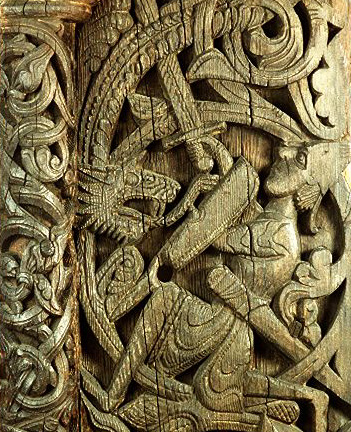
|
| Ægir fountain by J P Molin Kungstrádgården Stockholm |
Sigurðr slays Fáfnir Wood carving Hylestad Church, Norway |
It is said that only later did the physical symbol come into use, being carved inside the helmets of Viking warriors, displayed on their front, or else impressions made of it on warrior foreheads using blood, saliva or lead stencils. I don’t know who said this, but it seems highly unlikely. I have not seen any evidence of it, and as already stated, galdrastafir became popular in the 17th century, way after the Viking period from roughly 800 AD to 1100 AD. What quotes I provide here are mythological, which is not the same as historical fact. Stories that come from the Eddas are generally regarded as myth, whereas those from Icelandic sagas and other testamonies are embellished histories that might be fact. There are no sagas that tell of any kind of face painting, however some rare testamonies do say Vikings had dark painted eyes and had tattoos.

|
Galdrakver (A Book Of Magic) Lbs. 143 8vo, 1670 National Library and University of Iceland |
|
TRANSLITERATION †: Æirz hialmur hann skal giorast a blij og þrickia J enni sier þa madur a uön a ouin sijnum ad hann mæti honum og muntu hann Jferuinna (hann er so sem hier epter filger) ICELANDIC TRANSLATION †: Ægis hjálmur. Hann skal gjörast á blý og þrykkja í enni sér þá maður á von á óvin sínum, að hann mæti honum. Og muntu hann yfirvinna. (Hann er svo sem hér eftir fylgir): Note: Old Norse-Icelandic and Modern Icelandic are generally the same. Differences mostly relate to accents, spelling and punctuation, such as the interchange between
j, iand í. († Transliteration and translation by Ögmundur Helgason.) |
|
|
ENGLISH TRANSLATION (by Anna Yates): Terror Helm. It shall be ¦ made in lead, and when a man expects his ¦ enemies he shall imprint it on his forehead. And thou wilt conquer him. (It is as follows): |
|
|
⇧ Click the image to toggle on and off enhancements. Scribes throughout the middleages employed many ways to abbreviate their writing. In this manuscript omitted characters are indicated with an horizontal bar over or through preceding characters. Other abbreviations include a 7like character to replace erand a 3like squiggle to replace og(each shown coloured red in the enhancement). |
|
 |
Íslenzkar Þjóðsögur Og Æfintýri pp 452. 1862 - by Jón Árnason. (Translation by B Waggoner) |
|
Then there is the Helm of Awe [Ægishjálmur]. It was cast in lead, and the lead image was fastened to one’s forehead between the brows, as this spell shows:
Helm of Awe, that I bear ¦ between my brows.
A man had to face his enemies with this sign, and then victory was certain for that man. It was an equally certain defense against the wrath of rulers, and both this spell and the other spell whose verses went with it were proven. It goes like this:
I wash from me ¦ my enemies’ hatred,
the greed and wrath ¦ of powerful men. |
There are many examples of ægishjálmar on the internet which vary from those found in historical manuscripts. A few common traits for those found in manuscript include a squarish overall shape, triple cross-lines of equal length, and the cross-lines position often favouring the outer end of each spoke. Additionally, all spokes intersect in the center and there is an inner circle. This formula has not always been followed by contemporary artists - hopefully no harm has come of this.
The following three examples all come from compilations made in the first half of the 20th century and follow the same design as above. The best of these comes from LBS 4375, which specifically states it is a copy of a manuscript dated 1676. It also provides a correctly spelled title, and a formula which I have translated as follows:
This stave must be written using your blood and the leech (ring) finger of your right hand, and makes you fearless against your enemies whoever they may be.
More often than not the Icelandic instructions use the word rista
which is usually translated to carve or scratch. In this case a finger is used and there are other staves that require a bird's feather be used. I therefore think to write
makes more sense.
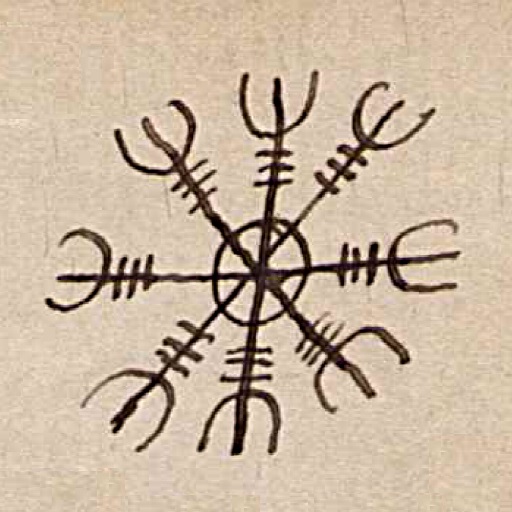 |
 |
 |
Ægishjálmurfrom LBS 4375 8vo by Finnbogi Bernódusson, 1900–1949 |
Ægirs-hjálmurfrom Rún, Stafabók by Magnús Steingrímsson, 1928 |
Ægishjálmurfrom Galdraskræða by Jochum (Skuggi) Eggertsson, 1940 |
There are several magical powers evoked when viewing this symbol. Personally I can can see the forked tongues of snakes, i.e. serpents. I can also see pitch-forks looking somewhat dangerous.
 |
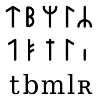 |
| Algiz/Elhaz Rune Elder Futhark |
Madr / Yr Runes Younger Futhark |
Nigel Pennick refers to the use of 8 Elhaz runes and suggests the 24 cross arms represent the 24 runes of the Elder Futhark.6
Crowfoot agrees on the possible use of the older Elhaz (aka Algiz) Z
rune, however he and others describe the significance of the cross arms as lines that act to accelerate or amplify the magical energy envoked by the sigil as a whole
.4
 |
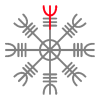 |
| Algiz Rune within Sigil |
Madr & Yr Runes within Sigil |
One modern meaning of the Z
Algiz (aka Elhaz) rune is protection
, which seems to fit perfectly. In a further twist, Algiz became the ʀ
(Yr) rune in the Younger Futhark. However the era and region point more to the use of the Younger Futhark Mad(h)r m
rune, which has a meaning of man
or human
and is regarded as the Life
rune in modern times. Although the shapes of the Z/ʀ
and M
runes have varied over time, each have taken on the distinctive or upside-down at some stage.
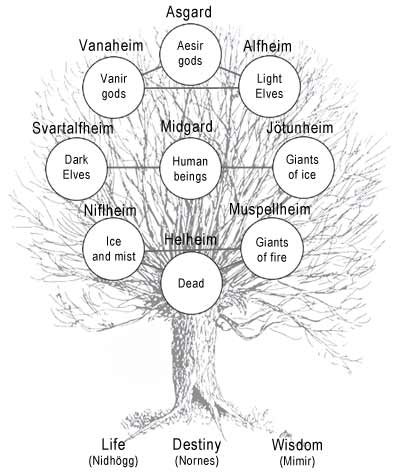 |
| Midgard, in the center of Yggdrasil |
Some suggest the center circle most likely represents one’s self surrounded by protective energy. Crowfoot describes all Ægishjálmar as having three zones: an outer ring (for the subjective universe), a middle range (the objective universe) and a centre region (the inner being).4 Robert Blumetti accurately describes that they all have the basic form of spokes radiating outward from a center point:
They all represent the basic cosmological blueprint of the Yggdrasil with nine worlds. This is especially true of the eight-spoke wheel sigils. Each spoke is one of the eight worlds that lie to the north, south, east, west and upper and lower worlds. The ninth world is in the center where all the spokes come together. This of course is Midgard.7
Yggdrasil is an immense ash tree encompassing all of the mythological Norse universe. Midgard, or Manheimr, is the home of men
(in Norse mythology Miðgarðr is the wall around the inner world of Midgard). This reinforces the M rune connection and conjures up the idea of the outer ring of terror being the protector of man’s life.
With the proliferation of Ægishjálmar over the internet this stave design has become popular with only this one version as shown above. However that impression would be incorrect. It would be far more accurate to regard the Ægishjálmar as a category of staves. Other Ægishjálmar can range in style from very simple to very complex; yet all do have a symmetry to them - they all have arms radiating out from the centre (usually 4 or 8 arms), have intersecting markings and end terminals that can either be cup shapes, circles, lines or crosses, or quite often runic or other mysterious characters, and they all are intended to influence the immediate area conditions of the bearer for betterment.
When not that as shown above their purposes extend beyond those of protection, empowering the wearer with strength and striking fear into the enemy. The following example from LBS 2413 shows 9 ægishjálmar to be used 99 times. The number nine is a significant number in the Northern Tradition; nine worlds of the tree Yggdrasill, nine nights the chief god Odin hung on that tree to seize runes to then learn nine powerful songs.
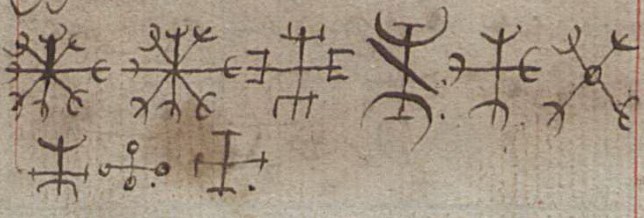 |
LBS 2413 8vo, ca. 1800. National and University Library, ReykjavíkThese are the nine Helms of Awe that noone can be without who will handle knowledge and each one should be used 99 times. |
Each of these helms are seen throughout the Grimoires either individually or in groups; used for good luck, to prevent misfortune, as a love inducement, to procure friendship or calm anger, to cure sickness, etc.
The following is taken from the notorious grimoire manuscript called the Galdrabók
, first published in the 1920s but presumed to be written and extended some time from 1550 through to 1650. It is thoroughly reviewed in Icelandic by Matthías V Sæmundsson in his 1992 book Galdrar í Íslandi
, is the main focus of the book by Stephen Flowers (now going by the name Edred Thorsson) in The Galdrabók - An Icelandic Grimoire
and undergoes much theorizing in the essay by Greg Crowfoot called Understanding the Galdrabók
.
In this section of manuscript, the first symbols are called ægishjálma
and are for sick cattle and winning girls.
 |
 |
 |
| ATA Ämb 2 F16:26. circa. late 16th C. State Historical Museum, Stockholm |
|
ICELANDIC TRANSLATION: (by Matthías V Sæmundsson) Þessa ægishjálma á maður að klippa eður rista á gripi ef aðsvíf eður faraldur fá og skal sá fyrri standa á vin- stra bógnum, sá seinni á þeim hægra. Item gjör með hrá- ka þínum fastandí þennan se- inni í lófa þér þá þú heilsar þeirri stúlku er þú vilt eiga. Það á að vera hægri höndin. |
ENGLISH TRANSLATION: (by Steven Flowers) One should clip or cut these helms of awe onto one’s livestock if they get swooning or pestilence, and the first one should be put on the left shoulder and the other one on the right. Likewise, while fasting, make the latter (helm of awe) with your spittle in your palm when you greet the girl whom you want to have. It should be the right hand. |
The next set of symbols are intended to cause fear in enemies, however they are referred to only as stafi
.
|
Ef þú vilt að óvinur þinn hafi hræðslu af þér er hann sér þig, þá rist þessa stafi á hr- íseik og ber milli brjósta þér og sjá svo til þú lítir hann fyrr en hann þig: |
If you want your enemy to be afraid of you when he sees you, then carve these staves on a piece of shrub-oak and wear it in the middle of your chest, and see to it that you see him before he sees you. |
* Note this manuscript is as the norm heavily abbreviated, usually indicated with the vertical stroke over where missing letters would ordinarily appear. Also note that letter characters take old germanic style with a long slooking like an fand standard fand klooking very odd indeed. |
The next section of the same manuscript is written by a different person and is less legible than the previous. Thankfully Matthías Sæmundsson has again translated it.
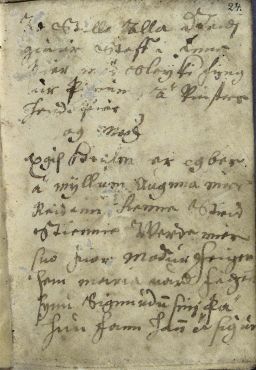 |
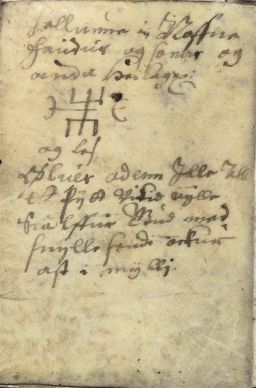 |
| ATA Ämb 2 F16:26. written early 17th C. State Historical Museum, Stockholm |
|
ICELANDIC TRANSLATION: (by Matthías V Sæmundsson) Að stilla alla reiði gjör staf í enni þér með sleikifing- ur þínum á vinstri hendi þér og mæl: Ægishjálm er eg ber á millum augna mér. Reiðin renni, strið stemmi. Verði mér svo hvör maður feginn sem María varð fegin sínu[m] signuðum syni þá hún fann hann á sigur- hellunni. Í nafni föður og sonar og anda heilags: [symbol] Og les: Ölver, Óðinn, Illi, all- t þitt vilið villi. Sjálfur Guð með snilli sendi okkur ást í milli.
In Icelandic prose:
Ölver, Óðinn, Illi, allt þitt vilið villi. Sjálfur Guð með snilli sendi okkur ást í milli. |
ENGLISH TRANSLATION: (by Steven Flowers) To calm all anger make this stave on your forehead with the index finger of your left hand and say: It is the helm of awe which I bear between my eyes. Let the anger melt, let the strife stop. May every man rejoice in me as Mary rejoiced in her blessed son when she found him on the victory- rock. In the name of the father and son and holy spirit: [symbol] And read: Ölver, Óðinn, Illi, everything may your will bewilder. May God himself with mastery, send love between us. |
What is remarkable, but not unique to this symbol, is the mixture of envoking both Christian and pagan gods. We again see that the symbol, despite having the same title, varies in its appearance, description and instructions.
This is a reminder that everything about galdrastafir was fluid and flexible, almost at the whim of the galdramenn who created them.
There is another manuscript version that I quite like, you can see it here: LBS 977 4to, Page 79, from the year 1818 and part of another wonderful compilation, although typically not easy to read. The instructions are similar, to make it on your forehead with saliva using your index finger, but this time from the right hand. I think it says it is to put fear into your enemies, but this needs checking.
As a final note, I have recently come across suggestions that the ægishjálmur is related to an ancient symbol called ashtánga yantra
(sometimes misspelt as asthanga yantra
). Whilst both the symbols’ appearance and meaning have similarities, this is just a coincidence. The ægishjálmur clearly evolved into the popular 8 spoke form over time, from around 1400 to mid-1600.
Vegvísir (Path Guide)
| Support my research |
|---|
| Buy this design. |
|
JF © 2014–2018
See this and other authenic designs for your tattoo, t‑shirt, wall, etc. SHOP |
The Vegvísir vegvisircan be seen in the Huld Manuscript 1 of 1860, translated to mean signpost
, however the word is derived from two Icelandic words: veg and vísir. Vegur
means road or path, and Vísir
stands for the word Guide. The instruction given to this symbol has been translated as If this sign is carried, one will never lose one’s way in storms or bad weather, even when the way is not known
.3
The design and translation taken from the publication called Galdraskræða Skugga is similar. That version was transcribed in 1940 but taken from earlier sources. Unfortunately the author did not share what those sources were.
Fen Alraun speculates that the Vegvísir vegvisirincorporates 8 different charms of protection on each stave; thus the overall charm becomes one suitable to defend against many kinds of obstacles that might cause one to lose one’s way. He believes it is not necessary to understand the meaning of each stave: As long as the helm is written correctly every time it will still hold its power
.
The Vegvísir has been called a Runic
or Viking Compass
and been described as a magical symbol of navigation connected with actual compasses.11 I am yet to find any reference to this sigil prior to the 1600s, so it should not be regarded as Viking. Even though the shape looks like a compass, that is just a coincidence - many galdrastafir appear on an eight pointed wheel. Meanwhile, the concept of an actual eight pointed compass used in navigation is only a very recent innovation.
While on the subject of debunking nonsense - Vegvísir was definately not created by Ásatrú, despite their use of this symbol today - Ásatrú is a new age religion founded in the 1970s. Also it is not in the same category of magic as the Elder Fathurk runes being used in esoteric runology
(another modern day innovation). The practice of drawing this or any galdrastafur surrounded by runes of any era is not supported in any pre 20th century manuscript. For artistic purposes, the symbol does look good
with runes around it - however they should at least be of the right era and region; i.e. Nordic early modern age. Finally, in my opinion it would also be better if the runes say something, rather than just give them in a list that would be a Latin alphabetic equivalent to A B C D E F ...
.
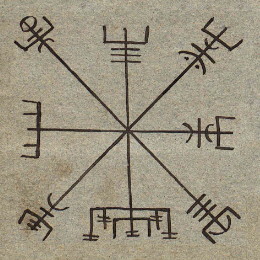 |
 |
 |
| Huld Manuscript 1 - Page 60 from Geir Vigfússon ca. 1860 |
Galdrakver - Lbs 4627 8vo unknown author, from 19C |
Galdraskræða - Column 49 by Jochum (Skuggi) Eggertsson, 1940 |
 |
|
| Beri maður stafi þessa á sér villist maður ekki í hríðum né vondu veðri þó ókunnugur sá |
Carry these staves with you and you won’t get lost in storms or bad weather, even though in unfamiliar surrounds. |
| Huld Manuscript1 - Text from Page 60... A collection by Geir Vigfússon ca. 1860 | |
The shape of the symbol in the Huld Manuscript is square whilst the one from Galdraskræða Skugga is designed to fit in a circle. The drawing made for Ólafur Davíðsson that he included in his 1903 essay 20 differs considerably from both, leaving out several elements and a blurred copy of this appears in Steven Flowers’ 1989 book The Galdrabók - An Icelandic Grimoire. Fen Alraun writes Little change is made to the power of the charm by making the staves all the same length. This effectively fits the charm inside a circle. There is no change to the charm because the symbols themselves have not changed.
10 However major omissions and variations make the Davíðsson version less credible. Unfortunately this has been even further simplified for a graphic version shown on old Wikipedia that others copied in great numbers.
 |
 |
| From an essay 20 by Ó Davíðsson, 1903 |
From a book 3 by Steven Flowers, 1989 |
There are many Vegvísir tattoos on Tumbler and Instagram, usually based on the Davíðsson or old Wikipedia versions. This does make for a more simple, less cramped style for tattooing, but I prefer accuracy over such shortcuts. There is also a version that is based on a low resolution image of Björk’s tattoo. After close examination it looks like Björk made a hand drawing of the Davíðsson version which she then took to her tattooist. Brent Barry has made a better version on his web site Brent Berry Arts and shows many other examples of his beautiful work featuring the Vegvísir (but they still lack those key elements).
In respect of what direction the symbol is drawn one commentator wrote It is not you who needs to see the design, it is the gods who will guide you, and they will see you as any observer would see you. I imagine that a reversed Vegvesir could possibly have the effect of steering you in the opposite direction to that desired.
Fen Alraun offers a different view: The orientation of the charm shouldn’t matter much, because this charm is about protection from 8 types of threats. It is not dependent on up, north or any direction
.
In my revision of Vegvísir I have taken the best elements from the earliest versions. The Huld version is from 1860 and the Galdraskræða Skugga from 1940, however both of these are the collectors’ impressions taken from earlier sources. I don’t understand what happened that the Ó Davíðsson, 1903 version is so abbreviated, but I cannot trust it. I heed Egil Skallagrimsson’s warning after finding a girl sick in bed and finding her the victim of a badly cast rune spell...
 |
Skalat maðr rúnar rísta nema ráða vel kunni. Þat verðr mörgum manni er um myrkvan staf villisk. - Egil’s Saga, Chapter 73 (74 in Bjarni) |
No man should carve runes unless he can read them well Many a man goes astray around those dark letters - translation by Bernard Scudder. |
Notwithstanding my earlier comments about esoteric runology
not applying here, there does appear to be runes taken from the Younger Futhark of 800AD, up to and including the Modified Danish Futhark of around 1300AD.
The best indicator of the runes used in the Vegvísir are the two dots used in the Up-Right pointing stave. The only runic alphabet that I have found which uses dots is the Modified Danish Futhark.12
It is possible that rune meanings can be derived from poems written for each rune character, and we can speculate that the designer of Vegvísir borrowed these meanings to add significance to the overall symbol.
 |
 |
|
| Þ:Thurs | G:Gebo | M : Mannaz / Man / Maðr (Madhr) |
The Þ
rune (pronounced th
) is Thurisaz or Thurs. Tyriel of Rune Magic writes that, among other things, Thurisaz means Giant
and is representative of Thor and his hammer, protecting Asgard from the thurses (Norse Giants)
13 The Norse god Thor had power over natural forces. Those natural forces
in this case would be storms or bad weather
. Whilst that meaning may fit, it is difficult to argue that the circle at the end of the Vegvísir’s Up-Left pointing stave is a double sided Thurs.
The G
rune in the Elder Futhark is Gebo and means gift
. This rune was dropped in the Younger Futhark but returned in the subsequent Medieval and Danish Futharks with a new shape and this may be what is being symbolized in the Up-Right pointing stave. Gebo refers to balance
and equilibrium
. How this relates to not getting lost
is not very clear. Perhaps if one is dizzy and confused you could easily become lost, so this rune is present to ensure that does not happen?
Whilst it is possible to think the Þ
or G
runes have been incorporated in the Vegvísir, it is undoubtedly clear the M
Maðr rune has been. This rune has taken many forms, but other than the Elder Fathark form (which can be ignored as it had not been used for hundreds of years at the time of the Vegvísir’s creation) all other later versions of this rune can be superimposed somewhere onto this symbol. The most common from at the time of around the 15th century was . The Huld, the Galdraskræða Skugga and several other manuscripts all list dozens if not hundreds of runic alphabets that attest to that.

|
|
|
A portion of MS AM 461 12mo fols, pp 15v-16r. Mid 16th century. Click on the manuscript to toggle on and off image enhancements. |
|
|
Icelandic Rune Poem (in Old and Modern Icelandic)
Madr er manz gaman
og molldar auki og ski pa skreytir ij Maðr: er manns gaman
ok moldar auki ok skipa skreytir. ( ... ) |
TRANSLATION 16, 17, 18 Maðr: is man’s delight (/joy) and earth’s (/dust’s) increase (/augmentation) and ships’ painter (/adorner). |
| Norwegian Rune Poem (in Old Norse) Maðr er moldar auki; mikil er græip á hauki. |
TRANSLATION Man is an increase (/augmentation) of the dust; great is the claw of (/at) the hawk. |
Bernard King writes This rune stands for man, either the individual or the race, and it was thought to possess powers for defence and protection.
21 His view regarding this rune’s powers is unique, however it is otherwise universally agreed upon. Most commentators also add that it refers to the person and those closest to them, i.e. the family. From the poems we get augmentation of the earth/dust
, which to me is talking about the middle ages farmer ploughing the soil, enriching it with fertilizer, on his farm - his home, where he lives with his family. It is here that he wants to return, if lost
at sea or in wild weather. If he is a trader, it is he who would keep the Vegvísir drawn on parchment and kept close to his chest, before setting out on long journeys.
Another common theme explains the first line of the Icelandic poem: mutual pleasure experienced under the sign of Mannaz is the pleasure of communicating and sharing
. Yves Kodratoff makes an attempt to interpret the Norwegian poem, believing the first line speaks of man’s birth rising out of dust and the second line of death and being carried off the battlefield by Odinn’s mythological hawk. Sweyn Plowright has translated moldar
as Mould in its meaning of soil/earth, as in the grave
24. These interpretations again bring us back to the Maðr/Algiz Life
and Yr Death
runes.
On a pragmatic level the rune poems were of the time when the Elder Farhark was still in use and they were more of a memory tool than anything else. The Icelandic version has lines which are simply other ways of saying man
. The first line of the Norwegian poem does the same, and the second line is just a bit of nonsense to provide a rhyme. It is purely conjecture that centuries later the galdramann designed Vegvísir chosing Maðr as its key rune based on runic poems.
There is one key that does tie it all together, i.e. the Vegvísir design, its meaning and the Maðr rune: In Hávamál, part of the Poetic Edda, verse 47 in Icelandic is as follows:
Ungur var eg forðum, fór eg einn saman, þá varð eg villur vega;
auðigur þóttumk, er eg annan fann, maður er manns gaman.
Translation (by W.H.Auden & P.B.Taylor)22 :
Young and alone on a long road, Once I lost my way:
Rich I felt when I found another; Man rejoices in man.
Should we keep the notion of Maðr being at the heart of Vegvísir, we can construct a stave portion as plus to get (which just on its own is another version of the Maðr rune).
Add and you have . This appears often in Vegvísir, but also is frequently seen in other Galdrastafir.
In this context, perhaps it means nothing more than person
, as in this charm applies to you
.
Or it may relate to my initial comments regarding the tvimadur shaped Thor/Jesus
symbol seen in so many galdrastafir?
Another simple solution can be deduced from other occurences of the sign in past manuscripts. In the following example, although the spell given is for a horse, it is obviously intended to provide protection:
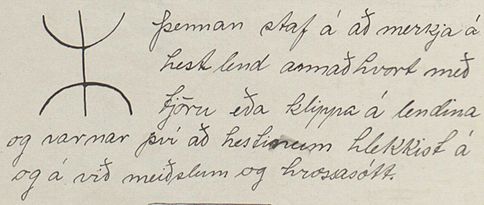
|
|
|
TRANSLITERATION: þennan staf á að merkja á hest lend annaðhvort með tjöru eða klippa á lendina og varnar þvi að hestinum hlekkist á og á við meiðslum og hrossasótt. - Image taken from Rún, page 75 |
TRANSLATION: mark this stave on the horse loins either with tar or clip the loins and prevent your horse having an accident with injury and colic. - my own very literal translation |
The square shaped Maðr may be what the magician had in mind for the end of each stave. However there is also stave modifiers as discussed above. This would then have the user gain from the energy flows. In this instance I would favour Thorson’s definition of power ... caught and held
. In addition, the triple cross lines could be the Maðr drawn thrice, or more likely is the stave modifier being used to amplify the magical energy
.
It also occured that scribes wrote using cipher runes
. These were written as codes using the Futhark divided into three groups called ætts
, and using the number of which ætt
and which character along, using dots, lines or curves, they could indicate which rune was meant.
 |
| Huld Manuscript 1 - Page 30 |
In Viking and later times this kind of code was especially prevalent in Iceland using Younger Futhark as key. This put the position of the M
rune in the third row third along and in cipher branch
rune style is in the Huld Manuscript as shown above within lines 132 and 133. Fashioned as straight lines we would again get the triple cross lines used in the Vegvísir.
Freya Aswynn offers one final twist. She tells of two myths relating the origins of mankind. The first is from the circa 98 AD book The Germania by Tacitus and tells of the god Mannaz
fathering three earthborn sons which lead to the three West Germanic tribes. The second is the story Rigsthula
from the Poetic Edda. In this the god Heimdal begets a son each to three earthly women which lead to three race classes; thralls, peasants and warriors.23 This may give further significance to the triple cross lines.
Lukkustafir (Good Luck Staves)
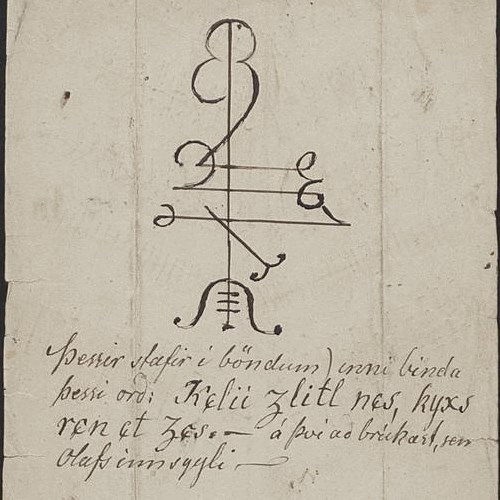 |
| Lukkustafur, Page 64 unknown, Lbs 4627 8vo |
| Support my research |
|---|
| Buy this design. |
|
JF © 2016–2018
See this and other authenic designs for your tattoo, t‑shirt, wall, etc. SHOP |
The Lukkustafir are good luck (Old Icel. Lukka
) staves whose purpose it is that the person carrying them will not suffer any misfortune (Old Icel. ſ l i ſ u m
= slys = mishap, mischance).
This popular stave was first brought to the attention through fans of the work of Steven Flowers / Edred Thorsson, however because of a big blunder (see link below) the correct symbol in the Huld manuscript was missed and a different stave given in its place in each of his books about the subject.
Sadly, I would not describe the correct version of the stave given in Huld as having a particularly appealing design. On the up side, I have recently uncovered a much ignored second design given in the manuscript indexed Lbs 4627 8vo
. In other words, Lbs 4627 8vo gave a copy of the Lukkustafir version found in Huld, but then later at the end of the manuscript gave this other design. The later design had no title and its purpose was hidden within a cypher.
It was not until another manuscript was uncovered, scanned and made public (by my request in fact) that the alternate version of the Lbs 4627 stave could be given its correct title and enable its cypher to be decrypted. In Lbs 4627 the cypher reads Kclii zlitl ncs, kyxs rcn ct zcs.
A letter switching provides a correct Icelandic stanza: Heill filgi mer, hvar sem eg fer.
Which translates to Fortune follow me, wherever I go.
In the other manuscript, indexed Lbs 2917a 4to
, this same stanza was instead written in Medieval Icelandic runes:
ᚼ ᛂ ᛁ ᛚ ᛚ ᛫ ᚠ ᛁ ᛚ ᚵ ᛁ ᛫ ᛘ ᛁ ᛂ ᚱ ᛬
ᚼ ᚢ ᛅ ᚱ ᛫ ᛋ ᛂ ᛘ ᛫ ᛂ ᚵ ᛫ ᚠ ᛂ ᚱ ᛬
 |
| Lukkustafir, Page 55 Geir Vigfússon, ÍB 383 4to |
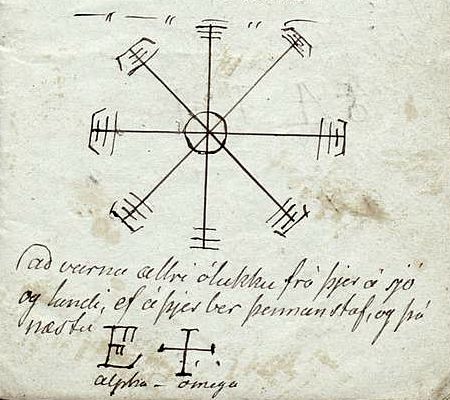 |
| Lukkustafir, Page 36 unknown, Lbs 4627 8vo |
The Lukkustafir in Huld comes with additional sub headings Alpha
and Omega
- the beginning and the end, a Christian title for God. Note the final piece of text sjó og landi
is written in slightly altered Danish Futhark runes: ᛋᛁᚮ ᚮᚵ ᛚᛆᚿᛑᛁ
.
|
ICELANDIC TRANSLATION: (by Arnar Gunnarsson) Sá er ber stafi þessa á sér mætir ekki slysum hvergi á sjó og landi. |
ENGLISH TRANSLATION: (by Arnar Gunnarsson) Whosoever bear these staves on him will not meet with mishaps nowhere on sea and land. |
The Huld version is confirmed plus a second alternate version of the stave is given in Lbs 4627 8vo. Here the text translates to:
To prevent bad luck [and] comforts you; on sea and land, if you carry this stave with you.
Curiously the alternate version bears remarkable similarity to the popular Ægishjálmur stave; an eight armed wheel, an inner circle and triple cross lines on each arm. The difference is only in the end terminals which are sharp cornered and cupped inwards rather than outwards. The implication being that Ægishjálmur prevents harm coming in and Lukkustafur keeps the luck in.
This is not a Lukkustafur stave! Full details on how this error came about, including all supporting source information, can be found on my separate pageThe Lukkustafir Blunder. |
Jónas Jónasson identifies other lukkustafir in his impressive early 1900s compilation and which can be found in the manuscript Lbs 267 8vo. The instruction beside the symbols reads ber það
, meaning carry it
.
 |
| Galdrastafir from Lbs 267 8vo |
 |
Galdrastafir #340, Lukkustafirhanddrawn in Lbs 267 8vo From the collection by Jonas Jonasson, Lbs 5472 4to, Part III |
Preceding these symbols appears the following Icelandic text:
Ad Manni Lukist fie gakk þrisvar rangsælis i kringumm þad og þrisvar riett sælis i kringumm fie þitt og les patur noster og skrifa med stali stafi þessa þar sem það liggur og geingur
This is followed by the Lord’s Prayer written in Latin (Icel. Pater Noster
), giving these symbols a particular Christian influence. It finishes with:
Þetta er bæninn og er góð enn þetta eru stafirnir so
With the kind assistance of Aðalheiður Guðmundsdóttir, we have translated this text as follows:
To be lucky with your livestock, walk three times around it counter wise and three times clock wise, and read pater noster and write with steel these staves, where it lies and walks around.
[Lord’s Prayer] ... Amen
This is the prayer and [it] is good, but these are the staves, like following...
All the key elements of the spell - walking around clockwise and anti clockwise, carving with steel, speaking Pater Noster - are also seen used in other galdradtafir spells.
Curiously, given in this manuscript immediately following the seven Lukkustafir, is a stave called Skuggabaldur
which has pagan references, and calls on the use of the Sator Arepo Tenet magic square, which dates all the way back to Roman times. Another example of the Icelandic magicians drawing on whatever inspiration they felt would help them: anything goes, nothing is off limits!
Finally are some staves from the manuscript titled Rúna og galdrakver
Lbs 2413 from Iceland written around 1800. The key word used here is Heill
rather than the previous Lukku
. The words appear to be synonyms and both have undergone a transition of their original meaning of luck
to present day happiness
:
- heill (-ar,-ir)
- luck, happiness, success | Concise Icelandic-English Dictionary, Reykjavík: Iðunn, 1989
- luck, omen, foreboding | A Concise Dictionary of Old Icelandic, Oxford Clareden Press, 1910
- good luck; A. an omen, auspice, foreboding; B. good luck, happiness | An Icelandic-English Dictionary, Oxford Clareden Press, 1874
- lukk/a (-u)
- happiness, joy | Concise Icelandic-English Dictionary, Reykjavík: Iðunn, 1989
- luck, good fortune | A Concise Dictionary of Old Icelandic, Oxford Clareden Press, 1910
- luck | An Icelandic-English Dictionary, Oxford Clareden Press, 1874
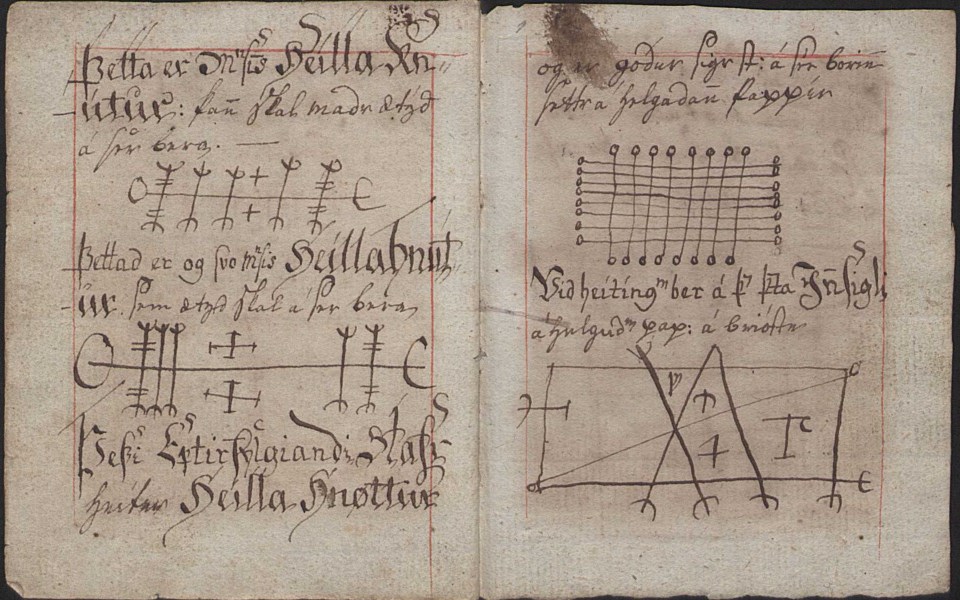 |
|
| Pages 37v and 38r from Lbs 2413 8vo | |
|
Þetta er mannsins Heillahnútur: Þann skal maður ætíð á sér bera
[stafur] Þettað er og svo mannsins Heillahnútur sem ætíð skal á sér bera [stafur] Þessi eftirfylgjandi stafur heitir Heillahnöttur og er góður sigurstafur á sér borinn settur á helgaðan pappír [stafur] |
This is the Luck-knot of man. It should always be carried on one’s body.
[stave] This is also a Luck-knot of man that should always be carried. [stave] The following stave is called a Luck-ring and is a good victory stave carried on sanctified paper. [stave] |
There is barely any difference between the first and second stave, which generally can be interpreted in two different ways. It frequently occurs that the same stave can be drawn in more than one way (particularly evident on Ægishjálmar and Rúðukrossar). It may mean that a particular stave can be drawn only in the ways given, or it may indicate that variations are acceptable. As the same stave often is drawn differently across different manuscripts, the latter is more likely to be the case - with the only real criteria being that it is recognisable as that symbol.
Galdrastafir Ritual Empowerment
| The Icelandic Tradition of Magic |
The Northern magical process differed from the traditional Southern approach in several ways. In the Southern formula there was a preparation of the ground (with a circle and triangle which was stood in) to protect the magician from the spirit called. The spirit was then ordered to perform some bidding. After the ritual the magician dismissed the spirit. The Northern way had no preparation. The spirit was called to assist or empower the magician rather than it do the work. And there was no specific dismissing at the end. Another difference between South and North was in the person of the magician: the Southern one required little experience whilst in the North the more skilled the better - it was more about the magician than the process.
In Icelandic Magick one or more of three methods was used: signs or symbols; writing; or spoken chants or words. In the case of Galdrastafir, this used the first with or without the later two.
The general technique of rune magic in pagan times consisted of three procedural steps performed by a qualified rune magician: (1) carving the staves into an object, (2) coloring them with blood or dye, and (3) speaking a vocal formula over the staves to load them with magical power.3
Egil then drew his knife and pricked the palm of his hand. He took the horn, scratched runes thereon, and smeared blood in them. He sang:
Write we runes around the horn,The horn burst asunder in the midst, and the drink was spilt on the straw below.5
Redden all the spell with blood;
Wise words choose I for the cup ...
Rituals often included blood along with other aspects: woods (ash, oak, alder ...); herbs (leek, mosses, rosemary, sage, ...) and stones (amber, ruby, diamond). With the growing conversion to Christianity from 1000 to 1550CE, prayers became more prominent and Christian entities were more often called upon. Along with the usual gods of Odin, Thor, Frig and Freya, now Jesus, Mary and Satan were included. Many of the charms transcribed into the various Galdrabok included the phrase In the name of the Father, the Son, and the Holy Spirit
From 1550 to 1750CE, the Protestant Reformation Age the quality of learning decreased and persecution of magic and magicians increased. Records of witchcraft trails in Iceland exist from 1554 to 1720, and peeked in the mid 1600s.
As a final call from esoteric witchcraft back to reality - I am yet to see any empirical evidence of galdrastafir being used in the Viking age or beyond through to late middle ages. There are no viking warrior gravesites which bore up a helmet with the Ægishjálmar carved within. No ships or mariner graves revealed a Vegvísir in use. And the power of runes
seems to be nothing more than myth.
Bibliography and References:
Huld Manuscript, ÍB 383 4to
by Geir Vigfússon, 1860Galdrabók
by various scribes, circa 1600The Galdrabók - An Icelandic Grimoire
by Stephen Flowers, Samuel Weise Inc., York Beach, Maine, 1989Understanding the Galdrabók & Creating Original Designs
by Greg Crowfoot, 1994The Poetic Edda
English, transl. W. C. Green, 1893, and English, transl. Henry Adams Bellows, 1936The Complete Illustrated Guide to the Runes
by Nigel Pennick, Element Books Ltd, Rockport MA, 1999- Robert Blumetti, Twelve Questions from The Hex Factory, 2012
- The History of Icelandic Sorcery from Museum of Icelandic Sorcery & Witchcraft
- Ægishjálmr: the Symbol Called the Helm of Awe from The Viking Answer Lady, 2005
- Travel Well by Fen Alraun, 2013
- Understanding the Symbols by wyrddesigns, 2010
- Runes in Denmark - Unknown author
- Runes Secrets - Study Community by Tyriel et. al.
- Introduction to the Runes: Younger Futhark (Chart) by Sunna Blalock
- Google Archive: Ægishjálmur (Helms of Awe) by Brad Lucas
Runic and Heroic Poems of the Old Teutonic Peoples
by Bruce Dickins, Cambridge University Press 1915Die Runenschrift
by Ludv. F. A. Wimmer, 1887 (Rune poems translation and notes by Yves Kodratoff)The Icelandic Rune-Poem
by R I Page, 1998- Danske runeinnskrifter fra vikingtiden Danish runic inscriptions of the Viking Age
Isländische Zauberzeichen und Zauberbücher
(an essay) by Ólafur Davíðsson, 1903The Elements of Runes
by Bernard King, 1997- maður er manns gaman Wikipedia verse description with multiple translations; and
Poetic Edda - Hávamál complete verse with two translations (incl. Auden & Taylor) Northern Mysteries and Magick: Runes & Feminine Powers
by Freya AswynnThe Rune Primer: A Down-to-Earth Guide to the Runes
by Sweyn PlowrightNorthern Magic: Rune Mysteries and Shamanism
by Edred Thorsson- Witchcraft in Iceland by Matthías Viðar Sæmundsson
- An Early Christian Cryptogram? by Duncan FISHWICK, M.A.



